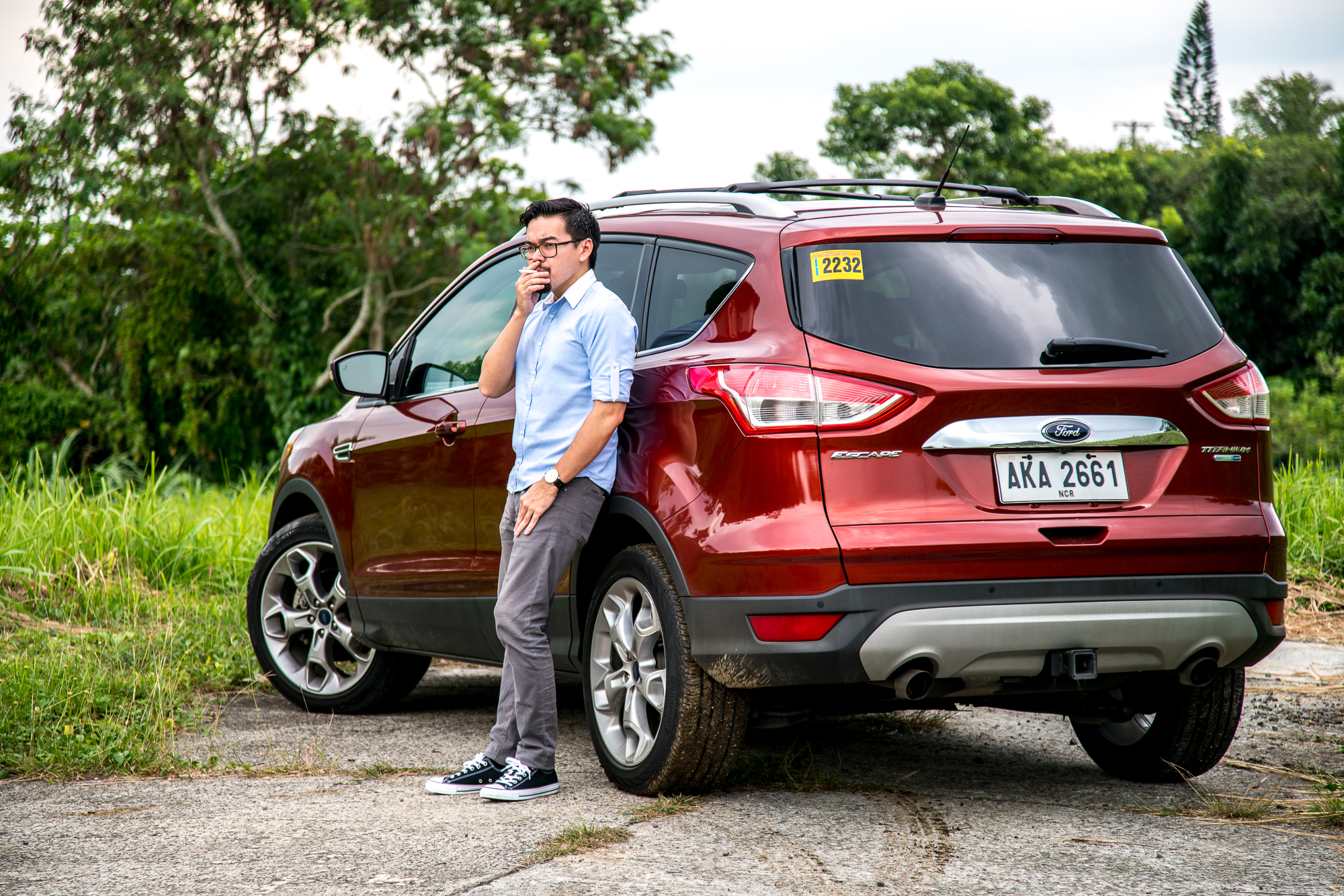Stockholm Syndrome

I surprised myself, I did. From the long list of Nissan models I could have taken for a lovely drive up to a Tagaytay wedding, I chose the Juke. Now you could take a look at the car and wonder, “Why would you choose to take a gimmicky-looking, 1.6l-powered, mini-SUV up some lovely mountain roads, Opus Macchina?” It’s a fair question, and I’ll be glad to explain my reasoning. You see, the Nissan Juke is different, and I like different. Here’s how one of the most polarizing cars of recent times took care of me, for better or worse, through a grueling Manila - Tagaytay - Manila weekend:
Photograph by Miguel Olfindo
Crippling self-doubt was the emotion of the day while waiting to pick up my tester. Why did I pick this one, again? The route to Tagaytay is mostly uphill, the destination a cool, breezy escape from the Metro. Enzo got it right, he took a lovely drop-top up for the occasion. Back to the Juke though; my screaming yellow unit was dropped off at our studio and I, keys in hand, made my rounds along village roads. It was set in Eco mode which totally did not help my first impressions of this cute ‘ute. Mashing on the gas pedal did little to nothing and the steering felt dead, at least around sleepy urban roads. The interior at first glance felt chintzy and was reminiscent of its exterior: gimmicky. Seriously, who signed off on the design of those door handles? Bottle-opener-shaped handles notwithstanding, the interior wasn’t a bad place to be in, all things considered. The seats were comfy, the driving position felt snug enough, and visibility was surprisingly outstanding. The Juke’s lethargic straight-line performance on tap was still a major buzzkill though. OK, so first impressions were pretty much as expected then: for the next five days I was stuck with an underpowered, overpriced, flashy car.
"You see, the Nissan Juke is different, and I like different."
Oh, how five days can change one’s mind.
It started with the brakes. See, I’m a huge sucker for well-weighted, progressive brakes. The Juke has well-weighted, progressive brakes. It was the first in a long list of good things this car can do that slowly chipped away at my over-exuberant, unjustified contempt. Brembo-clad sports cars costing more than twice as much aside, I haven’t experienced brakes that felt this naturally good and confident in a long while. OK, so it’s not all bad. These brakes are fantastic.
A quick look at my cheat sheet showed a figure of 38 meters on the standard 100-0 km/h braking test. That’s a very respectable figure to be sure, but what it doesn’t show is how great the pedal modulation actually felt. From a safety point of view then, I was beginning to like this little runabout.
Bad roads are part and parcel of living in the Philippines (they’re getting better though!), and this was the next challenge for my little Juke. There’s one particular patch of cobblestone driveway I like to use as a test that always brings out the worst in a car’s suspension which, to date, only our recently-featured FJ Cruiser was able to traverse with aplomb. Your typical sedan’s suspension would crash over the cobbles and complain about being exposed to such rough terrain, usually in a loud manner. Not so with the Juke; my highly-unscientific test failed to bring out even the slightest jitter or rattle from the suspension. Rock solid, this is. Impressive.
Photograph by Miguel Olfindo
Photograph by Miguel Olfindo
The story continued on my drive up to chilly Tagaytay: rough patches and potholes I’m intimately familiar with having driven this route dozens of times were handled with a complete absence of drama. The Juke is superbly damped without being wallowy (I’m looking at you, FJ Cruiser). It took corners with a reasonable amount of confidence, enough for me to push a little harder than I probably should have on certain sweeping corners. It did get a little nervous when pushed hard through the twisties, but that’s fine since it is a mini-SUV. Don’t get too cocky, this wasn’t made for the track. Overall though, I have to admit that Nissan dialed in the Juke’s suspension pretty much perfectly for Philippine roads.
"OK, so it's not all bad. these brakes are fantastic."
So let’s look at the scoreboard: The Juke’s adventurous brakes and impressive suspension damping are definite bright points. The interior was also starting to look less than horrible after a couple days so let’s take a deeper look there. This being a modern, “artsy” car, where function follows form, it’s not much of a surprise to find that the interior is seemingly aimed at millenials (I would assume). Dominated by glossy plastics and a couple of flashy LCD displays, one each for the entertainment center (which doubles as the backup camera display) and climate/drive settings, it really did seem a bit gaudy at first. As mentioned earlier, those circular door handles are also in loud attendance. Of all the things I didn’t warm up to after five days of living with the car, this was by far the worst offender. Someone could get their fingers stuck in there. After settling in however, I really started to feel comfy in it. The cupholders and little cubby holes are both numerous and exactly where you’d want them to be. The seats are a pleasant mix of fabric and something that felt like alcantara. Hmm. I actually don’t mind that the seats aren’t leather. There’s plenty of space too, especially when you fold the rear seats down: it swallowed an extra bulky load of wedding reception supplies without any issue. The Juke won a few more points from its skeptical reviewer then for its solid practicality.
Photograph by Miguel Olfindo
Photograph by Miguel Olfindo
The climate/drive controls here are notable for pulling off an interesting trick. The display is shared for both functions, which is nothing new, but the labels on the buttons change depending on which setting you’re on. It sounds like a simple gimmick, and on the surface it kind of is, but you have to see it in person to appreciate how nifty switching between both modes looks. Anyway, about the function of the panel itself: the climate controls are pretty self-explanatory so it’s the drive function that we’ll take a look at in detail. This is where you switch between Normal, Eco, and Sport. The much-maligned Eco mode basically kills what feels like 90% of your throttle input and switches your A/C to a more conservative mode. Where did the power go? Is my fuel pump flooded? This is the mode you’re going to want to be in while puttering around the city in heavy traffic. Sport mode on the other hand is where you’ll probably want to be in most of the time, with the CVT and throttle response being dialed up to 10. Sadly, this is where the Juke falls flat, as this particular engine-and-tranny pairing just doesn’t work well together (more on this later) and so even on sport mode the car doesn’t ever feel, well, sporty. Our third and final mode, Normal, has a bad case of middle child syndrome: it’s not as sporty as Sport nor does it have the singular purpose of saving you as much gas as possible like Eco mode so you’re probably not going to be using it much, if at all.
Now on to the meat and potatoes of any automobile: the go-fast bits. Right, so the engine is your standard fare 1.6 liter four-pot that pushes out 115 bhp and 154 Nm of torques. It’s not the best engine out there, not by a long shot, but neither is it terrible. It shrieks rather than sings to its 6,000 rpm redline and hits 100 kph in a leisurely 11.5 seconds, but it gets the job done and returns some really decent fuel consumption figures. I averaged about 10 Km/L on my aggressive drive through the traffic-congested roads down south which is really quite impressive. The Juke's transmission is of the CVT persuasion, something I’m not a really big fan of especially when paired with smaller-displacement engines. Unfortunately, this is exactly the case here. Mashing on the gas pedal brings the needle up to around 5,500 rpm and holds it there, in typical CVT fashion, for what feels like forever as the Juke casually accelerates. It feels like I’m stuck in first gear. I hope people around me don’t think I’m stuck in first gear. Now I’ve seen CVT units that work well, but that’s when they’re paired with beefier engines. This is because you get to your desired speed quicker with a bigger engine and thus won’t experience sounds-like-you’re-stuck-in-first-gear syndrome, which is really a terrible affliction especially when your engine shrieks rather than sings as mentioned before. This engine paired with this transmission isn't ideal at all and I hope Nissan avoids this combination in the future.
Photograph by Miguel Olfindo
It's really too bad that we only get the NA-CVT variant locally, as I'm sure the 1.6 turbo unit would have done this chassis proper justice. In fact, Nissan's confidence in this chassis is such that there was a limited run of Jukes fitted with the mighty GTR's engine. Yep.
I have to admit, I was expecting to dislike the Juke. It looked a bit funny, cost as much as a Mazda 3 (among other stellar cars at this price point), and had a tragic engine-tranny pairing. For the first half of my time with it, I couldn’t see much past those gripes. As the days went by though, I started to secretly like the damn thing. I started to look forward to even little trips as an excuse to hop in and press that orange engine start button. I started to not just appreciate but revel in the commanding ride height, the perfectly-tuned suspension, and the awesome way it could fly through imperfect asphalt with arrogant panache. I started to brake harder than necessary, just to feel those great brakes throw me forward against my seatbelt. I even started to like how it looks, at the attention I’d get wherever I went. At the end of my time with it I really had taken to liking this practical, comfortable, and downright interesting mini SUV. Stockholm syndrome had set in; I'm definitely gonna miss this little bugger.
"Stockholm syndrome had set in; I'm definitely gonna miss this little bugger."
2016 Nissan Juke 1.6 CVT Automatic
| Engine: | 1,598cc, DOHC 16V Twin CVTC, Inline-4 |
| Fuel: | Gasoline |
| Power: | 116 bhp @ 6,000 rpm |
| Torque: | 154 Nm @ 4,000 rpm |
| Transmission: | XTRONIC CVT, FWD |
| 0-100 km/h: | 11.5 seconds |
| Top Speed: | 170 km/h |
| Fuel Economy: | 15 km/L Overall |
| Price: | PHP980,000 |
| +: | Well-damped suspension, ride height, fuel economy, standard equipment |
| -: | CVT, polarizing styling |
| Verdict: | More capable than its cutesy exterior might suggest, plagued by poor transmission |
| Rating: | 7/10 |














